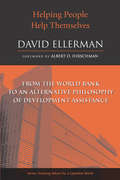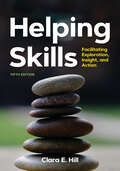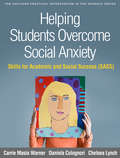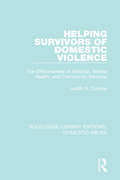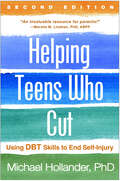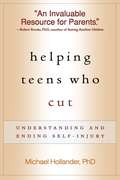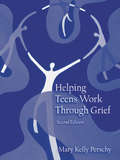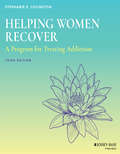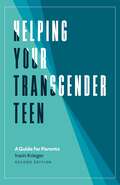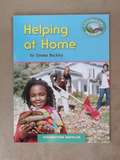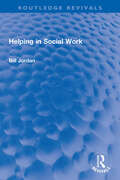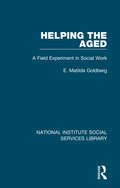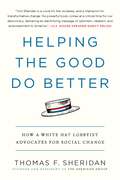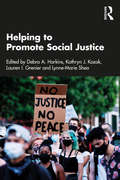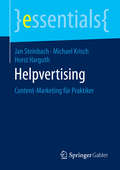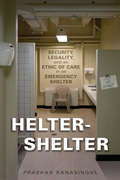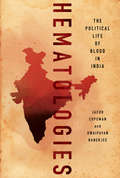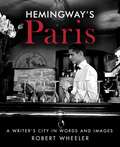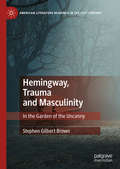- Table View
- List View
Helping People Help Themselves: From the World Bank to an Alternative Philosophy of Development Assistance
by David EllermanDavid Ellerman relates a deep theoretical groundwork for a philosophy of development, while offering a descriptive, practical suggestion of how goals of development can be better set and met. Beginning with the assertion that development assistance agencies are inherently structured to provide help that is ultimately unhelpful by overriding or undercutting the capacity of people to help themselves, David Ellerman argues that the best strategy for development is a drastic reduction in development assistance. The locus of initiative can then shift from the would-be helpers to the doers (recipients) of development. Ellerman presents various methods for shifting initiative that are indirect, enabling and autonomy-respecting. Eight representative figures in the fields of education, community organization, economic development, psychotherapy and management theory including: Albert Hirschman, Paulo Freire, John Dewey, and Søren Kierkegaard demonstrate how the major themes of assisting autonomy among people are essentially the same. David Ellerman is currently a Visiting Scholar in the Economics Department at the University of California at Riverside.
Helping Relationships With Older Adults: From Theory to Practice (Counseling and Professional Identity)
by Adelle M. WilliamsHelping Relationships with Older Adults: From Theory to Practice examines the fundamental theoretical perspectives of the aging process with an emphasis on the healthy aspects of aging. Taking a comprehensive approach, author Adele Williams addresses various therapeutic methods as she highlights the strengths and resiliency of the older population. Exercises and case studies demonstrate key concepts and promote skill development by allowing students to experience the various challenges in the lives of older clients.
Helping Relationships With Older Adults: From Theory to Practice (Counseling and Professional Identity)
by Adelle M. WilliamsHelping Relationships with Older Adults: From Theory to Practice examines the fundamental theoretical perspectives of the aging process with an emphasis on the healthy aspects of aging. Taking a comprehensive approach, author Adele Williams addresses various therapeutic methods as she highlights the strengths and resiliency of the older population. Exercises and case studies demonstrate key concepts and promote skill development by allowing students to experience the various challenges in the lives of older clients.
Helping Skills for Counselors: Fundamental Counseling Skills and Principles
by Anne GeroskiThis text offers a comprehensive introduction to the basic tenets of mental health-related counseling. Aimed at graduate-level students studying mental health counseling, school counseling, or similarly related professions, this text will enable students to become familiar with the foundational skills required to implement various counseling approaches and to work in diverse counseling environments.
Helping Skills: Facilitating Exploration, Insight, and Action
by Clara E. HillIn this fifth edition of her best‑selling textbook, Clara Hill presents an updated model of essential helping skills for undergraduate and first‑year graduate students. Hill&’s model consists of three stages—exploration, insight, and action—in which helpers guide clients in exploring their thoughts and feelings, discovering the origins and consequences of maladaptive thoughts and behaviors, and acting on those discoveries to create positive long‑term change. This book synthesizes the author&’s extensive clinical and classroom experience into an easy‑to‑read guide to the helping process. Aspiring helping professionals will learn the theoretical principles behind the three‑stage model and fundamental clinical skills for working with diverse clients. Hill also challenges students to think critically about the helping process, their own biases, and what approach best aligns with their therapeutic skills and goals. New to this edition are: detailed guidelines for developing and revising case conceptualizations, expanded coverage of cultural awareness, updated case examples that reflect greater diversity among clients and helpers, and additional strategies for addressing therapeutic challenges.
Helping Students Overcome Social Anxiety: Skills For Academic And Social Success (sass) (The Guilford Practical Intervention In The Schools Series)
by Carrie Masia Warner Daniela Colognori Chelsea LynchSocial anxiety disorder causes significant distress and academic impairment for many adolescents. This unique book gives front-line school professionals innovative, easy-to-use tools for identifying and intervening with socially anxious students in grades 6–12. It presents Skills for Academic and Social Success (SASS), a school-based intervention with demonstrated effectiveness. Case examples and sample scripts demonstrate how to implement psychoeducation, cognitive strategies, social skills training, exposure, and relapse prevention with groups and individual students. In a large-size format with lay-flat binding for easy photocopying, the book includes 22 reproducible handouts. Purchasers get access to a Web page where they can download and print the reproducible materials. This book is in The Guilford Practical Intervention in the Schools Series, edited by T. Chris Riley-Tillman.
Helping Survivors of Domestic Violence: The Effectiveness of Medical, Mental Health, and Community Services (Routledge Library Editions: Domestic Abuse #2)
by Judith S. GordonFirst published in 1998, this study investigates the effectiveness of services for helping women who are survivors of domestic violence. Looking at a sample from Western and Central Oregon, it examines the utilization and perceived effectiveness of resources for survivors and, in doing so, it systematically assesses the efficacy of community and professional services. This book will be of particular interest to social work students and practitioners, but will also be helpful to those studying healthcare and law.
Helping Teens Who Cut, Second Edition: Using DBT Skills to End Self-Injury
by Michael HollanderDiscovering that your teen &“cuts&” is every parent's nightmare. Your most urgent question is: "How can I make it stop?" Tens of thousands of worried parents have turned to this authoritative guide for information and practical guidance about the growing problem of teen self-injury. Dr. Michael Hollander is a leading expert on dialectical behavior therapy (DBT), the most effective treatment approach for cutting. Vivid stories illustrate how out-of-control emotions lead some teens to hurt themselves, how DBT can help, and what other approaches can be beneficial. You'll learn practical strategies for talking to teens about self-injury without making it worse, teaching them skills to cope with extreme emotions in a healthier way, finding the right therapist, and helping reduce stress for your whole family. Incorporating the latest research, the second edition offers a deeper understanding of the causes of self-injury and includes new DBT skills.
Helping Teens Who Cut: Understanding and Ending Self-injury
by William Pollack Michael HollanderDiscovering that your teen "cuts" is absolutely terrifying; before you understand what really motivates cutting, you may worry your child is contemplating suicide. What can you do to help when every attempt to address the behavior seems to push him or her further away? In this compassionate, straightforward book, Dr. Michael Hollander, a leading authority on self-injury, spells out the facts about cutting--and what to do to make it stop. You'll learn how overwhelming emotions lead some teens to hurt themselves, and how proven treatments--chief among them dialectical behavior therapy (DBT)--can help your child become well again. Helping Teens Who Cut demonstrates how to talk to your teen about cutting without making it worse, and explains exactly what to look for in a therapist or treatment program. Drawing on decades of clinical experience as well as the latest research, Dr. Hollander provides concrete ways to help your son or daughter cope with extreme emotions without resorting to self-injury. You'll also learn practical communication and problem-solving skills that can reduce family stress, making it easier to care for yourself and your teen during the recovery process.
Helping Teens Work Through Grief
by Mary Kelly PerschyThe second edition of Helping Teens Work Through Grief provides a more complete and updated manual for facilitators of teen grief groups. It includes additional background information about developmental aspects of teens, the process of grief, aspects of trauma and its effects on teens, the value of a group, determining the group-appropriateness of particular teens, and parental involvement. The many details involved with beginning a group - publicity, interviews, registration, structure, closure, evaluation, and follow-up - are listed.
Helping Vulnerable Children and Adolescents to Stay Safe: Creative Ideas and Activities for Building Protective Behaviours
by Katie Wrench Ginger KadlecHelping vulnerable children and young people to build protective behaviours is the key to keeping them safe. Full of creative ideas and activities, this guide provides the tools to help children develop these key skills. Topics include work around: building resilience and problem solving skills; identifying a 'safety network'; developing emotional literacy; awareness of grooming strategies and safe/unsafe touch; and cyber safety. The range of tried and tested techniques will be sure to engage any child in thinking about their personal safety, allowing adult carers to have confidence that their child will be empowered to better identify and avoid harmful situations and behaviours. Practical and easy to use, this is a valuable resource for professionals working with vulnerable children and young people, such as adopted or fostered children and those in residential care, as well as the parents and carers of these children.
Helping Women Recover: A Program For Treating Addiction
by Stephanie CovingtonSince it was first published in 1999, Helping Women Recover has set the standard for best practice in the field of women's treatment. Helping Women Recover is based on Dr. Covington's Women's Integrated Treatment (WIT) model. It offers a program specifically designed to meet the unique needs of women who are addicted to alcohol and other drugs or have co-occurring disorders. The package consists of a Guide for Facilitator's and a Journal for clients, which can be sold in a package or separately. There is also a version for the Corrections Community. This thoroughly revised and updated edition includes new coverage on opioid addictions, becoming trauma informed and trauma responsive, LBGTQ, and increased coverage on various religious traditions including Judaism, Hinduism and Islam. The Helping Women Recover program offers counsellors, mental health professionals, and program administrators the tools they need to implement a gender-responsive, trauma-informed treatment program in group therapy settings or with individual clients.
Helping Young Refugees and Immigrants Succeed
by Gerhard Sonnert Gerald HoltonIt has become a major challenge for the United States' public policy, educational system, and non-governmental aid organizations to help the vast numbers of young immigrants and refugees to have successful lives and careers and to fulfill their potential in their new country. In a unique effort, this book brings together, for the first time, scholarly analyses by eminent researchers of the historical, social, legal, and cultural influences on the young newcomers' lives as well as reports by practitioners in major aid organizations about the concrete work that their organizations have been carrying out.
Helping Your Transgender Teen, 2nd Edition: A Guide for Parents
by Irwin KriegerGoing through puberty and adolescence presents unwelcome changes for many transgender youth, and this book provides advice to parents of transgender teens to help them understand what their child is experiencing and feeling during this challenging time. Addressing common fears and concerns that parents of transgender teens share, the book guides them through steps they can take with their child, including advice on hormones and surgery and how to transition socially. It addresses the recent increase in teens presenting with non-binary identities, and reflects major legal, social and medical developments regarding transgender issues. The author's insights are gained from his professional experience of providing psychotherapy regarding gender identity. He provides resources and further reading to help parents expand their knowledge. Although aimed predominantly at parents, this book is useful for anyone working with teenagers and young adults as it provides many answers to common questions about adolescent gender identity.
Helping at Home (Houghton Mifflin Vocabulary Reader Accompanies Journeys)
by Emma BuckleyNIMAC-sourced textbook <P><P>Level E DRA 8 Social Studies Strategy
Helping in Social Work (Routledge Revivals)
by Bill JordanFirst published in 1979, Helping in Social Work elaborates on the personal processes of influence in social work between clients and social workers. Shifting focus from the organizational structure of social work to face-to-face interactions, the author expounds on the personal and qualitative components in social work. The aim of this book is to present a simple, practical and positive account of the elements that make up good practice in the sort of work which statutory social workers do, without relying on excessive jargon. These experiences of helping and being helped will be of importance to students of social work and social policy as well as any reader trying to gain an insight into the everyday realities of social workers.
Helping the Aged: A Field Experiment in Social Work (National Institute Social Services Library)
by E. Matilda GoldbergIn 1970 social workers were in great demand and their numbers were growing. At the same time questions were asked on both sides of the Atlantic about the methods they employed, their objectives and the effectiveness of their efforts. Previous studies undertaken in the United States to test the effectiveness of social casework had led to intense controversy between researchers and practitioners. Originally published in 1970, the field experiment described in this book was the first British attempt to assess the effectiveness of social work. A team led by a social worker, including a physician and a statistician, assessed the social and medical conditions of 300 aged applicants to a local authority welfare department and determined their needs for help. Half of these old people were randomly selected to receive help from trained caseworkers; the other half, also randomly chosen, remained with experienced local authority welfare officers without professional training. The social and medical conditions of the surviving clients were reassessed after an interval. Both sets of social workers had achieved much in alleviating practical needs. But the trained workers brought about more change in their clients’ activities, feelings and attitudes. The opinions of the old people about the services they received and the social workers who had carried them out added another dimension to this pioneer study which contributed to research methodology, helped to clarify operational goals in social work, made a beginning in measuring social work effort and enlarged our meagre knowledge of social work with old people at the time.
Helping the Good Do Better: How a White Hat Lobbyist Advocates for Social Change
by Thomas F. SheridanHow to effect positive social change by the top progressive white hat lobbyist in Washington.HELPING THE GOOD DO BETTER pulls back the curtain on the corridors of power in Washington to reveal how social change really happens. This book offers lessons from the trenches on how some of this generation's most defining social issues-AIDS, disabilities, global poverty, cancer, human trafficking, national service, early childhood education, and social entrepreneurship -- engendered landmark federal policies. Each chapter tells the story of how a particular issue was shaped by the movements and legislation at the center of public debate. Each case provides powerful lessons about how coalitions are built, strategies crafted, and powerful interests challenged in high-stakes, no-holds-barred political battles.Doing good requires more than just providing programs and services. It requires coordination, organization, and a new, stronger emphasis on and dedication to advocacy. Participating in advocacy is no longer a luxury -- it is a necessity. Visionaries and activists together with "white hat" lobbyists -- people who understand the power of politics and who are able to put it to work to serve the public interest -- have won some of the most transformative policy fights in recent times. The culmination of those experiences, of fighting and winning on behalf of public interest causes, is presented here in a new theory for social change. Successful campaigns and movements must possess a lobbyist's combined approach to policy, politics, and press. Leveraging these 3 Ps, with true passion and discipline, can create results that are nothing short of awe-inspiring.An insightful first-person guide to advocacy by a white-hat lobbyist who was in the rooms where historic social changes were made, HELPING THE GOOD DO BETTER is a direct and honest look at government in action and the behind-the-scenes players who help make progress a reality. p.p1 {margin: 0.0px 0.0px 0.0px 0.0px; text-align: justify; line-height: 12.1px; font: 13.0px Times} p.p2 {margin: 0.0px 0.0px 0.0px 0.0px; text-align: justify; line-height: 12.1px; font: 13.0px Times; min-height: 16.0px} p.p3 {margin: 0.0px 0.0px 0.0px 0.0px; text-align: justify; line-height: 10.1px; font: 13.0px Times; min-height: 16.0px} p.p4 {margin: 0.0px 0.0px 0.0px 0.0px; text-align: justify; line-height: 10.1px; font: 13.0px Times}
Helping to Promote Social Justice
by Debra A. Harkins; Kathryn J. Kozak; Lauren I. Grenier; Lynne-Marie SheaHelping to Promote Social Justice is a richly informed and practical guide for advanced students and young professionals to become helpers capable of promoting social justice with whomever they collaborate with, mentor, serve and consult. Filled with insight and supplemental exercises, the book will direct readers to think critically and reflect on the broader social and political systems that create our current social injustices. Beginning with a strong theoretical focus on power, social identity and intersectionality, the authors engage with readers’ assumptions on helping, their value systems and their understandings of power and privilege when helping communities in need. The rest of the book focuses on the application of these critical concepts, guiding future helpers to consider how to intervene, assess need, lead, build a team, address conflict and work to promote change from a position of social justice. Written by academic faculty with expertise in teaching, coaching and consulting, Helping to Promote Social Justice should be considered essential reading for students in social work, psychology and counselling.
Helpvertising: Content-Marketing für Praktiker (essentials)
by Jan Steinbach Michael Krisch Horst HarguthJan Steinbach, Michael Krisch und Horst Harguth zeigen, dass es beim Content-Marketing weniger um die Unterbrechung durch Werbung, sondern vielmehr darum gehen sollte, hilfreiche Inhalte mit Mehrwert zu entwickeln. ,Helpvertising' stellt dar, wie Sie diese Form des Marketings erfolgreich in Ihrer Unternehmenspraxis einsetzen können. Unterbrechende Werbung soll dazu dienen, die Aufmerksamkeit auf die Produkte und Leistungen zu lenken und ein Kaufbedürfnis auszulösen. Diese Form des Marketings ist für Kunden nicht sonderlich attraktiv und für Unternehmen immer ineffizienter. Im digitalen Zeitalter wollen Menschen zunehmend selbst entscheiden, ob, wo, wann und wie sie mit Unternehmen interagieren. Daher benötigen wir im Marketing eine neue Denkweise. Die Autoren nennen diesen Ansatz Helpvertising.
Helter-Shelter: Security, Legality, and an Ethic of Care in an Emergency Shelter
by Prashan RanasingheHelter-Shelter is an ethnographic account of the manner in which an emergency shelter is governed on a daily basis, from the perspective of the personnel who are employed and tasked with providing care. Prashan Ranasinghe focuses on how the founding ethos of the shelter, an ethic of care, is conceptualized and practiced by examining its successes and failures. Ranasinghe reveals how this logic is diluted and adulterated because of two other important logics, security and legality, which, working alongside, take precedence and trump the import of care. The care that is deployed is heavily legalized and securitized and it is also administered inconsistently and idiosyncratically. As a result, disorder and confusion pervade the shelter. Helter-Shelter offers a unique perspective on the delivery of care, and how this laudable intention faces such daunting challenges.
Hematologies: The Political Life of Blood in India
by Jacob Copeman Dwaipayan BanerjeeIn this ground-breaking account of the political economy and cultural meaning of blood in contemporary India, Jacob Copeman and Dwaipayan Banerjee examine how the giving and receiving of blood has shaped social and political life. Hematologies traces how the substance congeals political ideologies, biomedical rationalities, and activist practices.Using examples from anti-colonial appeals to blood sacrifice as a political philosophy to contemporary portraits of political leaders drawn with blood, from the use of the substance by Bhopali children as a material of activism to biomedical anxieties and aporias about the excess and lack of donation, Hematologies broaches how political life in India has been shaped through the use of blood and through contestations about blood. As such, the authors offer new entryways into thinking about politics and economy through a "bloodscape of difference": different sovereignties; different proportionalities; and different temporalities. These entryways allow the authors to explore the relation between blood's utopic flows and political clottings as it moves through time and space, conjuring new kinds of social collectivities while reanimating older forms, and always in a reflexive relation to norms that guide its proper flow.
Hemingway's Geographies
by Laura Gruber GodfreyThis book draws on the tools of literary analysis and culturalgeography to investigate Ernest Hemingway's sophisticated construction ofphysical environments. In doing so, Laura Gruber Godfrey revises conventional approachesto Hemingway's literary landscapes and provides insight about his fictionalcharacters and his readers alike.
Hemingway's Paris: A Writer's City in Words and Images
by Robert WheelerWalk through the Streets of Paris with Ernest Hemingway. In gorgeous black and white images, Hemingway’s Paris depicts a story of remarkable passion--for a city, a woman, and a time. No other city in any of his travels was as significant, professionally or emotionally, as was Paris. And it remains there, all of the complexity, beauty, and intrigue that Hemingway described in the pages of so much of his work. It is all still there for the reader and traveler to experience--the history, the streets, and the city. Restaurants, hotels, homes, sites and favorite bars are all detailed here. The ninety-five black and white photographs in Hemingway’s Paris are of the highest caliber. The accompanying text reveals Wheeler’s deep understanding of the man; his torment, talent, obstacles and the places of refuge needed to nurture one of the preeminent writers of the twentieth century. Moved by the humanistic writing of the man--a writer capable of transcending his readers to foreign settings and into the hearts and minds of his protagonists--Wheeler was inspired to travel throughout France, Italy, Spain, Africa, and Cuba, where he has sought to gain insight into the motivation behind Hemingway’s books and short stories. As a teacher, lecturer, and photojournalist, he set out to capture and interpret the Paris that Ernest Hemingway experienced in the first part of the century. Through his journal and photographs, Wheeler portrays the intimate connection Hemingway had with the woman he never stopped loving, Hadley, and with the city he loved most, Paris.
Hemingway, Trauma and Masculinity: In the Garden of the Uncanny (American Literature Readings in the 21st Century)
by Stephen Gilbert BrownHemingway, Trauma and Masculinity: In the Garden of the Uncanny is at once a model of literary interpretation and a psycho-critical reading of Hemingway’s life and art. This book is a provocative and theoretically sophisticated inquiry into the traumatic origins of the creative impulse and the dynamics of identity formation in Hemingway. Building on a body of wound-theory scholarship, the book seeks to reconcile the tensions between opposing Hemingway camps, while moving beyond these rivalries into a broader analysis of the relationship between trauma, identity formation and art in Hemingway.
